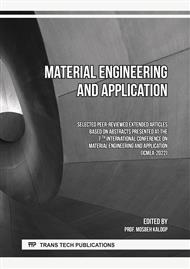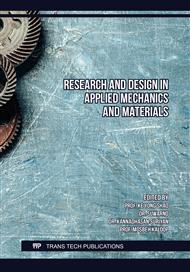[1]
J. Zhang, S. Shen, Low Platinum Fuel Cell Technologies, Springer, (2021).
Google Scholar
[2]
A. Elgowainy, Electric, Hybrid, and Fuel Cell Vehicles (Encyclopedia of Sustainability Science and Technology Series), Springer, (2021).
Google Scholar
[3]
Kulikovsky, The effect of Nafion film on the cathode catalyst layer performance in a low-Pt PEM fuel cell, Electrochemistry Communications. 103 (2019) 61-65.
DOI: 10.1016/j.elecom.2019.05.003
Google Scholar
[4]
L.V. Nam, E. Choi, S. Jang, S.M. Kim, Patterned mesoporous TiO2 microplates embedded in Nafion® membrane for high temperature/low relative humidity polymer electrolyte membrane fuel cell operation, Renewable Energy. 180 (2021) 203-212.
DOI: 10.1016/j.renene.2021.08.062
Google Scholar
[5]
M. Vinothkannan, A.R. Kim, S. Ramakrishnan, Y.-T. Yu, D.J. Yoo, Advanced Nafion nanocomposite membrane embedded with unzipped and functionalized graphite nanofibers for high-temperature hydrogen-air fuel cell system, Composites Part B: Engineering. 215 (2021) 108828.
DOI: 10.1016/j.compositesb.2021.108828
Google Scholar
[6]
R. Sun, Z. Xia, Z. Zhang, X. Xu, F. Jing, S. Wang, G. Sun, Supportless Pt-ionomer hybrid porous nanofibrous networks with self-regulated water management for polymer electrolyte fuel cells, Materials Today Nano. 18 (2022) 100215.
DOI: 10.1016/j.mtnano.2022.100215
Google Scholar
[7]
P. Samant, J.B. Fernandes, Insitu FTIR studies for the enhanced activity of Pt(HY) and Pt-Ru(HY) zeolite catalysts for electrooxidation of methanol in fuel cells, Chemical Physics Letters. 745 (2020) 137277.
DOI: 10.1016/j.cplett.2020.137277
Google Scholar
[8]
J. Xi, K. Meng, Y. Li, M. Wang, Q. Liao, Z. Wei, M. Shao, J. Wang, Performance improvement of ultra-low Pt proton exchange membrane fuel cell by catalyst layer structure optimization, Chinese Journal of Chemical Engineering. 41 (2022) 473-479.
DOI: 10.1016/j.cjche.2021.11.013
Google Scholar
[9]
A.N. Stuzhuk, A.V. Shkolnikov, P.S. Gorbatov, I.A. Gritskova Influence of the nature of the emulsifier and polymer concentration on the dispersion and stability of artificial polymer suspensions based on polycarbonate and polymethylmethacrylate, Fine chemical technologies. 16 (2021) 490-501.
DOI: 10.32362/2410-6593-2021-16-6-490-501
Google Scholar
[10]
Q. Li, D. Aili, H.A. Hjuler, J.O. Jensen, High Temperature Polymer Electrolyte Membrane Fuel Cells. Springer, (2016).
DOI: 10.1007/978-3-319-17082-4
Google Scholar
[11]
A.P. Antropov, A.V. Ragutkin, M.V. Lebedeva, N.K. Zaitsev, N.A. Yashtulov, Development of membrane-electrode blocks for energy-efficient autonomous energy sources, Bashkir Chemical Journal. 28 (2021) 90-96.
DOI: 10.33693/2313-223x-2019-6-4-56-59
Google Scholar
[12]
M.V. Lebedeva, A.P. Antropov, A.V. Ragutkin, N.A. Yashtulov, Platinum nanoelectrocatalysts for hydrogen-air energy sources, Computational nanotechnology. 7 (2020) 26-29.
DOI: 10.33693/2313-223x-2020-7-1-26-29
Google Scholar
[13]
N.A. Yashtulov, M.V. Lebedeva, L.N. Patrikeev, N.K. Zaitcev, New polymer-graphene nanocomposite electrodes with platinum-palladium nanoparticles for chemical power sources, eXPRESS Polymer Letters. 13 (2019) 739-748.
DOI: 10.3144/expresspolymlett.2019.62
Google Scholar
[14]
A.P. Antropov, A.V. Ragutkin, M.V. Lebedeva, N.A. Yashtulov, Nanocomposite micro-powerful alternative energy sources for electronic equipment, Thermal engineering. 68 (2021) 21-29.
DOI: 10.1134/s0040601521010109
Google Scholar
[15]
N.A. Yashtulov, M.V. Lebedeva, V.R. Flid, Catalysts with palladium nanoparticles on porous silicon for autonomous systems in microelectronics, Kinetics and Catalysis. 58 (2017) 833-838.
DOI: 10.1134/s0023158417060143
Google Scholar



